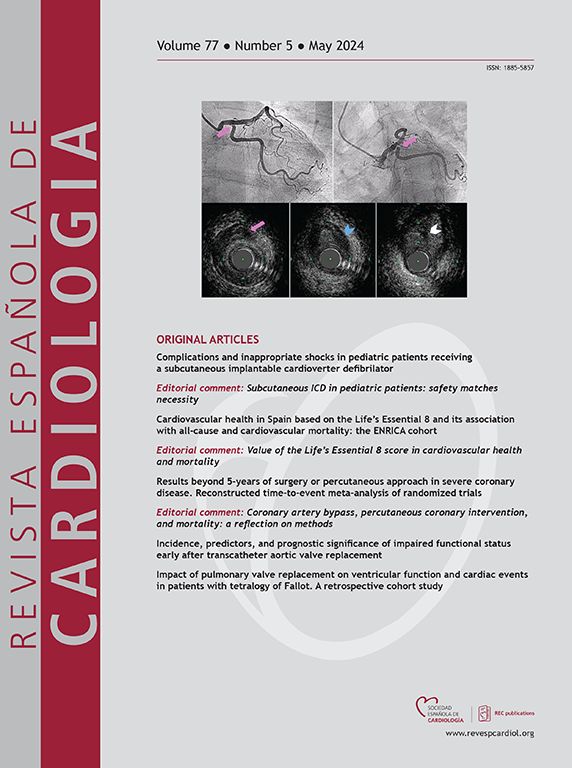Desarrollo y puesta en marcha de un plan nacional de salud cardiovascular. Estrategia en salud cardiovascular (ESCAV) española
IF 5.9
2区 医学
Q2 Medicine
引用次数: 0
Abstract
Introduction and objectives
Cardiovascular disease (CVD) remains the leading cause of death in most countries; however, few specific political actions have been implemented to improve cardiovascular health at both national and international levels. We aimed to describe the methodology used for the development and initial rollout of Spain's Cardiovascular Health Strategy of the National Health System (ESCAV, Estrategia en Salud Cardiovascular del Sistema Nacional de Salud).
Methods
A multidisciplinary team comprising diverse stakeholders developed a national strategy to reduce the burden of CVD in Spain. The team used qualitative methodologies to identify and select priorities and design strategic map models.
Results
The strategy was structured around a matrix with 6 cross-cutting themes (citizen empowerment; health promotion, prevention, and early CVD detection; comprehensive management of acute and chronic CVD; health care coordination; equity; and knowledge management) and 4 longitudinal lines (ischemic heart disease, heart failure, arrhythmias, and valve disease). The framework was further supported by 3 overarching axes: continuity of care, patient safety, and leveraging of information systems. A total of 27 critical points were selected, leading to the definition of 99 strategic objectives (32 general and 67 specific) and 136 actions through iterative reviews and prioritization. Strategic maps were developed for the overall strategy and for each action line, incorporating 61 indicators to facilitate and monitor the development of the strategy.
Conclusions
ESCAV represents one of the most ambitious initiatives aimed at transforming a nation's cardiovascular health. The methods and steps undertaken in this process could serve as a valuable reference for other countries seeking to establish similar initiatives. Furthermore, it may act as a catalyst to advance efforts toward establishing a European plan for cardiovascular health.
制定和实施全国心血管健康计划。西班牙心血管健康战略
简介和目的心血管疾病(CVD)仍然是大多数国家的主要死亡原因;然而,在国家和国际两级,为改善心血管健康而采取的具体政治行动很少。我们的目的是描述用于制定和初步推出西班牙国家卫生系统心血管健康战略(ESCAV, Estrategia en Salud Cardiovascular del Sistema Nacional de Salud)的方法。方法一个由不同利益相关者组成的多学科团队制定了一项减少西班牙心血管疾病负担的国家战略。该团队使用定性方法来确定和选择优先级,并设计战略地图模型。结果该战略是围绕6个交叉主题(公民赋权;促进健康、预防和早期发现心血管疾病;急慢性心血管疾病的综合管理;卫生保健协调;股本;(知识管理)和4条纵线(缺血性心脏病、心力衰竭、心律失常和瓣膜疾病)。该框架得到了三个总体轴的进一步支持:护理的连续性、患者安全和信息系统的利用。总共选择了27个关键点,通过反复审查和确定优先顺序,确定了99个战略目标(32个一般目标和67个具体目标)和136项行动。为整个战略和每项行动制定了战略地图,其中包括61项指标,以促进和监测战略的制定。sescav是旨在改变一个国家心血管健康状况的最雄心勃勃的举措之一。在这一进程中采取的方法和步骤可以作为寻求建立类似倡议的其他国家的宝贵参考。此外,它还可能成为推动建立欧洲心血管健康计划的催化剂。
本文章由计算机程序翻译,如有差异,请以英文原文为准。
求助全文
约1分钟内获得全文
求助全文
来源期刊

Revista espanola de cardiologia
医学-心血管系统
CiteScore
4.20
自引率
13.60%
发文量
257
审稿时长
28 days
期刊介绍:
Revista Española de Cardiología, Revista bilingüe científica internacional, dedicada a las enfermedades cardiovasculares, es la publicación oficial de la Sociedad Española de Cardiología.
 求助内容:
求助内容: 应助结果提醒方式:
应助结果提醒方式:


